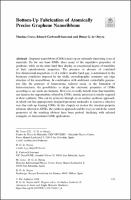Chapter Bottom-Up Fabrication of Atomically Precise Graphene Nanoribbons
| dc.contributor.author | Corso, Martina, | |
| dc.contributor.author | Carbonell-Sanromà , Eduard | |
| dc.contributor.author | Oteyza, Dimas G. de, | |
| dc.contributor.author | Corso, Martina | |
| dc.contributor.author | Carbonell-Sanromà, Eduard | |
| dc.contributor.author | de Oteyza, Dimas G. | |
| dc.date.accessioned | 2020-03-18 13:36:15 | |
| dc.date.accessioned | 2020-04-01T12:34:26Z | |
| dc.date.accessioned | 2018-07-17 23:55 | |
| dc.date.accessioned | 2020-03-18 13:36:15 | |
| dc.date.accessioned | 2020-04-01T12:34:26Z | |
| dc.date.available | 2020-04-01T12:34:26Z | |
| dc.date.issued | 2018 | |
| dc.identifier | 1000307 | |
| dc.identifier | OCN: 1076726179 | en_US |
| dc.identifier.uri | http://library.oapen.org/handle/20.500.12657/29630 | |
| dc.description.abstract | Graphene nanoribbons (GNRs) make up an extremely interesting class of materials. On the one hand GNRs share many of the superlative properties of graphene, while on the other hand they display an exceptional degree of tunability of their optoelectronic properties. The presence or absence of correlated low-dimensional magnetism, or of a widely tunable band gap, is determined by the boundary conditions imposed by the width, crystallographic symmetry and edge structure of the nanoribbons. In combination with additional controllable parameters like the presence of heteroatoms, tailored strain, or the formation of heterostructures, the possibilities to shape the electronic properties of GNRs according to our needs are fantastic. However, to really benefit from that tunability and harness the opportunities offered by GNRs, atomic precision is strictly required in their synthesis. This can be achieved through an on-surface synthesis approach, in which one lets appropriately designed precursor molecules to react in a selective way that ends up forming GNRs. In this chapter we review the structure-property relations inherent to GNRs, the synthesis approach and the ways in which the varied properties of the resulting ribbons have been probed, finalizing with selected examples of demonstrated GNR applications. | |
| dc.language | English | |
| dc.relation.ispartofseries | Advanced in Atom and Single Molecule Machines | |
| dc.subject.classification | thema EDItEUR::T Technology, Engineering, Agriculture, Industrial processes::TQ Environmental science, engineering and technology | en_US |
| dc.subject.other | Fabrication | |
| dc.subject.other | atomically | |
| dc.subject.other | nanoribbons | |
| dc.subject.other | Fabrication | |
| dc.subject.other | atomically | |
| dc.subject.other | nanoribbons | |
| dc.subject.other | Band gap | |
| dc.subject.other | Chirality | |
| dc.subject.other | Doping (semiconductor) | |
| dc.subject.other | Electron | |
| dc.subject.other | Electronic band structure | |
| dc.subject.other | Energy level | |
| dc.subject.other | Graphene | |
| dc.subject.other | Graphene nanoribbon | |
| dc.subject.other | Valence and conduction bands | |
| dc.title | Chapter Bottom-Up Fabrication of Atomically Precise Graphene Nanoribbons | |
| dc.type | chapter | |
| oapen.identifier.doi | 10.1007/978-3-319-75810-7_6 | |
| oapen.relation.isPublishedBy | 6c6992af-b843-4f46-859c-f6e9998e40d5 | |
| oapen.relation.isPartOfBook | a1fabd94-b3d8-42a1-9783-9122fbd7408c | |
| oapen.relation.isFundedBy | 178e65b9-dd53-4922-b85c-0aaa74fce079 | |
| oapen.relation.isbn | 9783319758107 | |
| oapen.collection | European Research Council (ERC) | |
| oapen.pages | 40 | |
| oapen.grant.number | 635919 | |
| oapen.grant.acronym | SURFINK | |
| oapen.grant.program | H2020 | |
| oapen.remark.public | Relevant Wikipedia pages: Band gap - https://en.wikipedia.org/wiki/Band_gap; Chirality - https://en.wikipedia.org/wiki/Chirality; Doping (semiconductor) - https://en.wikipedia.org/wiki/Doping_(semiconductor); Electron - https://en.wikipedia.org/wiki/Electron; Electronic band structure - https://en.wikipedia.org/wiki/Electronic_band_structure; Energy level - https://en.wikipedia.org/wiki/Energy_level; Graphene - https://en.wikipedia.org/wiki/Graphene; Graphene nanoribbon - https://en.wikipedia.org/wiki/Graphene_nanoribbon; Valence and conduction bands - https://en.wikipedia.org/wiki/Valence_and_conduction_bands | |
| oapen.identifier.ocn | 1076726179 |

